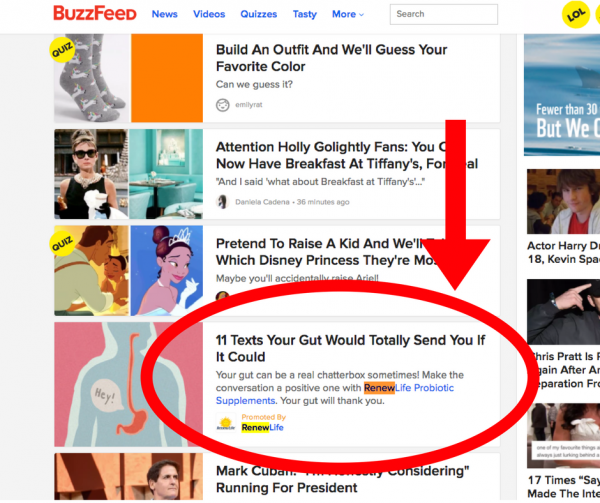B2B Myth of the Week: My Brand Doesn’t Need Personas
by MGB2B
The Myth: My Company Doesn’t Need to Develop Buyer Personas
The Truth: Buyer Personas Help You Produce Content That Works
“Why do we need personas when we know our target audience like the backs of our hands?”
This is a question that many Marketing Directors and CEOs are quick to ask. After all, no one knows your customers better than you, right? But buyer personas bring a lot more to the table than a general target audience can. And with the constant evolution of ways to target buyers, personas are essential for developing a strong content marketing plan.
As B2B buyer behavior continues to change and marketing tactics change along with it, it’s important to know more about your audience than ever before. Personas are fictional characters who represent your brand’s potential buyers or customers. Make them highly detailed with information based on solid research. Details can include everything from name and age to pain points at work to how they spend their spare time. Since personas contain so much detail, they enable your brand to segment your content. Which ensures that the content you create resonates with the persona it was created for.
Here Are the Benefits of Developing Buyer Personas:
- Personas provide a deeper understanding of buyer wants and needs. Although personas are fictional, they are based on the behaviors and preferences of real buyers. Therefore, they are able to provide important insights into what buyers are looking for from your brand. Personas include detailed information about both demographics and behavior patterns. Thus, they enable you to focus on forming connections with your audience. It’s important to include information about responsibilities at work, family dynamics, and media consumption. This will ensure your persona receives messages from your brand that will resonate.
- Personas allow you to segment your audience with more ease. CEO Richard and Millennial Kevin face very different challenges while on the job. Their home lives are different. And the way they consume information is different as well. So why would you deliver a piece of content to Millennial Kevin that was written for CEO Richard? You wouldn’t. But he is an important part of the decision-making process. So you need content for him as well. And that content won’t likely resonate with CEO Richard. By creating personas that define age, buyer behavior, media consumption, and pain points, you’ll be able to segment with more ease. And hit more home runs with your content program.
- Personas help you create the right content. Once you have an idea of your ideal customers, you will be able to create content that is appealing to them. You need to get your audience interested in the content you create. Otherwise, you’ll get more unsubscribes and fewer converted leads. Get insight into the types of content that pique their interest by including details like your persona’s role at work or what they do in their spare time. A well-done persona will help you create specifically targeted content that appeals to the individual that it represents.
- Personas show you where your audience is spending time online. When you’re trying to reach potential buyers, it’s important to know what types of media appeal to them and where they find information. If your persona is a CEO who doesn’t understand how Twitter works, then you should put your time and money in a different direction when targeting him/her. Creating detailed personas will show you where you should be spending marketing dollars to generate the most leads. Your company will save time, money, and resources if you are aware of the specific places your personas visit – both online and off.
- Personas create consistency throughout your whole company. Share your personas with your marketing team. But also include other departments. Your sales and product development teams, for example, should fully understand your brand’s personas and how to appeal to them. Some brands – like MailChimp – even have portraits of their personas on the walls to remind employees on a regular basis about their importance. It’s essential to familiarize your employees with the personas so they know how to interact with potential buyers. Personas ensure that everyone in your company is on the same page about who your audience is and how your brand can help them overcome challenges and seize opportunities.
These are some of the benefits to keep in the back of your mind while developing your brand personas. With accurate and realistic personas, you won’t just be shooting in the dark with your marketing program. You’ll motivate your leads to buy and increase the likelihood that they’ll come back to buy more.
Continue ReadingMarketing in Camouflage: Native Advertising for Manufacturers
by Emily Swet
Native advertising for manufacturing brands can be a mighty tool in your marketing arsenal. And with native predicted to drive 74% of ad revenue by 2021, it’s worthy of consideration. Let’s take a closer look at the basics of native advertising to see if it’s a good fit for your manufacturing brand.
First, What Is Native Advertising?
Native advertising is an ad format that looks like the editorial content around it. It’s different from content marketing, which is unpaid and lives on your website and social channels. Instead, native ads are paid placements in publications (or their online counterparts) that offer other value to your customers.
Isn’t That Just a Fancy Word for an Advertorial?
Advertorials are similar: longer-form ads written in an editorial style to evoke the same experience as a publication they are placed in. You’ve likely heard of them – they’ve been around since the 1940s (and are the precursor to today’s infomercial). Advertorials are generally much more promotional. They usually focus on the benefits of the product/service being offered and often push to sell.
In contrast, native ads usually focus on highly targeted content from which the reader can gain value. There is less emphasis on the product behind the article, and no sales pitch. Brands gain value in return by positioning themselves as thought leaders in their industry, building trust and brand affinity.
What Are the Benefits?
- They Are Appealing. Consumers view native advertising more often then banner ads.
- They Are Empowering. When done correctly, native ads give prospects the power to find solutions to their problems.
- The Leads Are Good. Because the content is relevant and highly targeted, you get more high-quality leads. This is particularly true if you are putting native ads on the sites of niche trade publications.
What Are the Drawbacks?
- Scalability. Producing native ads can be demanding. Each ad needs to look and sound like part of its environment. That means you risk authenticity or value, especially under a deadline, if you push for quantity.
- It can be perceived as deceptive. People don’t want to be tricked. There’s a delicate balance: your content must flow naturally with the publication. But you also can’t leave your reader feeling betrayed when they notice it’s sponsored. Your content should be relevant and insightful or useful in some way.
- One bad apple spoils the bunch. There are plenty of brands creating native ads that are simply too promotional. This makes some consumers leery of native ads in general. But according to Forbes, standards for native are set to increase, making it necessary for advertisers to follow rules and regulations.
What Does This Mean for Your Brand?
To conclude, native advertising can fall right in your prospect’s wheelhouse – if it’s done right. Offer something useful to your buyer from the outset, and you’ll build loyalty and name recognition. (And pull them into your sales funnel.) But like any kind of advertising, native ads require expertise, testing, and evaluation to monitor your success rates.
Continue Reading


